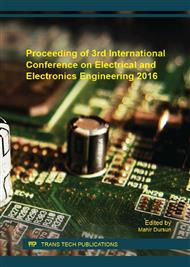[1]
M Younis, M Youssef, K Arisha. Modeling, Analysis and Simulation of Computer and Telecommunications Systems, 2002. MASCOTS 2002. Proceedings. 10th IEEE International Symposium on. IEEE, 129-136(2002).
DOI: 10.1109/mascot.2002.1167054
Google Scholar
[2]
R Wang, G Liu, C Zheng. Mechatronics and Automation, 2007. ICMA 2007. International Conference on. IEEE, 372-376(2007).
Google Scholar
[3]
S Cheng, T Chang. Expert Systems with Applications, 39(10), 9427-9434(2012).
Google Scholar
[4]
I F Akyildiz, W Su, Y Sankarasubramaniam, et al. Computer networks, 38(4), 393-422(2002).
Google Scholar
[5]
J N Al-Karaki, R Ul-Mustafa, A E Kamal. High Performance Switching and Routing, 2004. HPSR. 2004 Workshop on. IEEE, 241-245(2004).
DOI: 10.1109/hpsr.2004.1303478
Google Scholar
[6]
A Manjeshwar, D P Agrawal. Parallel and Distributed Processing Symposium, International. IEEE Computer Society, 3, 30189a(2001).
Google Scholar
[7]
O Younis, S Fahmy. Mobile Computing, IEEE Transactions on, 3(4), 366-379(2004).
Google Scholar
[8]
S Lindsey, C S Raghavendra. Aerospace conference proceedings, 2002. IEEE. IEEE, 3, 3-1125(2002).
Google Scholar
[9]
M Cardei, D Du. Wireless Networks, 11(3), 333-340(2005).
Google Scholar
[10]
J Chang, L Tassiulas. IEEE/ACM Transactions on Networking (TON), 12(4), 609-619(2004).
Google Scholar
[11]
Y Chen, Q Zhao. Communications Letters, IEEE, 9(11), 976-978(2005).
Google Scholar
[12]
M Ye, C Li, G Chen, et al. Performance, Computing, and Communications Conference, 2005. IPCCC 2005. 24th IEEE International. IEEE, 535-540(2005).
DOI: 10.1109/pccc.2005.1460363
Google Scholar
[13]
W R Heinzelman, A Chandrakasan, H Balakrishnan. System Sciences, 2000. Proceedings of the 33rd Annual Hawaii International Conference on. IEEE, 10-12(2000).
Google Scholar
[14]
L I Qiu-Luan, G H Zhan, L I Zhi-Hua. Transducer & Microsystem Technologies, (2014).
Google Scholar
[15]
W Yi, Z Deyun, L Taotao. Journal of XI'AN Jiaotong University, 42(4), 389-394(2008).
Google Scholar
[16]
Y Sun, J Peng, T Liu, et al. Journal on Communications, 35(1), 198-206(2014).
Google Scholar
[17]
C Jiang, W Shi, X Tang, et al. Journal of Software, 23(5), 1222-1232(2012).
Google Scholar
[18]
H Hu, F Zhang. Chinese Journal of Sensors and Actuators, 19(2), 477-480(2006).
Google Scholar
[19]
J F Xu, F Xu, Q L Meng. Applied Mechanics and Materials. Trans Tech Publ, 644, 2707-2710(2014).
Google Scholar


